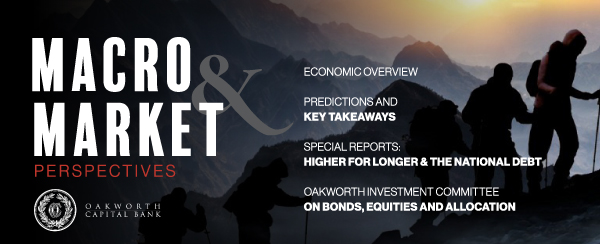Call it recency bias, but I think it would shock some people to hear that the S&P 500 is down roughly 2 percent for the third quarter. The first month of the quarter seemed to just be a continuation of the first half of the year, however since then, it has been a slog.
- On the last day of July, the Treasury announced they would be refilling their coffers with close to 2 trillion dollars by issuing new bills, notes, and bonds.
- A few days after, on August 2nd, they announced the composition of that near-2 trillion – which would be heavily weighted in notes and bonds rather than bills.
- Coincidentally, this was the very same day that Moody’s downgraded the United State Credit rating. This announcement, despite the first two bullets, is the one that seemed to have received all headline attention.
The combination of all three of these, however, has led to the last two months of the quarter being flooded by the phrase “higher for longer”.
ASSET ALLOCATION
Looking through an asset allocation lens, it begs the question, how do we try to position ourselves and our portfolios if higher for longer is where things are headed?
- Firstly, it is important to understand that when higher for longer is thrown around, it really means interest rates and subsequently long-term interest rates will be higher, for a longer period of time than the market has originally priced in. That implies things will have to change to get to where the market is in agreement. When I say things, think asset prices. These changes – and changes in interest rate and the expectations for their direction – have a significant impact on all asset classes, and the moves we have made have been with the intent of capturing these changes.
- While the more intuitive change in asset prices is for fixed income securities, rates have an impact on equity markets as well. It is plenty complicated to nail down every reason for changes in stock prices, however one simple explanation is this: higher interest rates tend to be bad for equities because higher rates mean future cash flows are worth less than current ones and equities pay out over a significantly long period of time. Especially so in companies that are not currently making a profit, and the positive cash flows are very far out in the future. This is one of the simpler reasons why in periods of rising long-term interest rates, securities that are making money currently tend to outperform.
This has led us to search for opportunities by adding to value names – i.e., stocks and assets that are considered undervalued in the market. The traditional view of value versus growth is typically pretty rudimentary and largely splits the companies in an index into the ‘more expensive’ and ‘less expensive’ portion.
We, however, prefer to look at “value vs. growth” as companies that are growing and are at a reasonable price, which looks at the cheap versus expensive through the lens of what is justified.
For example: A company that is growing 100% a year with a 20x P/E may actually be cheaper than a company not growing at all, at a 10x P/E.
All this to be said, we continue to find opportunities to add to GARP value names, or names that are ‘growing at a reasonable price’. This is why technology names that may traditionally be thought of as growth names can continue to be a part of a portfolio that is shifting more towards value. No matter which way you look at it however, in a period of rising interest rates it is important to have a portfolio with companies that are making a profit here and now, and not some promise of future profits down the line.
Higher interest rates can have a headwind effect and it is important to continue to overweight the markets and economies that are the strongest. It should not come as a surprise that we continue to maintain that overweight to domestic markets. When we looked abroad, there are a whole host of headwinds for global economies, however the United States is still positioned as the strongest with GDP still growing at a pretty steady rate.
BONDS
Like Michael Jordan in 1995, bonds have made a comeback in 2023. It was not long ago that bonds were just a part of a portfolio as a way to add diversification… last year proves that this is not always the case. Now however, the short end of the yield curve all has a five handle (i.e. 5% or greater). Solid yields are easy to be found and that is with little or no risk. That means bonds are great right?
Not exactly.
Bond math is fun to almost no one, so to save some time I can put it simply.
- When bond yields move higher, it is bad for bond prices, and the longer the bond is (longer duration) the more the price is impacted by higher interest rates. This makes sense intuitively. If I locked in 1% for 30 years, and now I can get 4.5% for 30 years, I really won’t like that 1% return.
- However, in that same situation but for 1 year then yes, I won’t like it, however it’s only for a year. I can get the better rate after the bond matures.
The point is this: if you expect rates to rise, you keep your bond portfolio duration short. This is exactly what we’ve done and because of that our fixed income allocation has been able to ride the wave better than if we were to extend duration out.
CASH
On top of short duration bonds, there is another asset class that is essentially a zero duration bond, and that’s cash. If bonds are like Jordan in ’95 then cash has been Jordan in ’96-’97. Cash instruments, like money market funds, have been flooded with inflows this year as the riskless asset class is not only dry powder, ready to be deployed given the right opportunity, but also a legitimate yield generating asset class.
It’s easy to find cash instruments paying over 5% now, and that includes the cash sweep that we utilize in our portfolios. Because of this we continue to have an overweight cash position.
There is no better asset to smooth out volatility in a portfolio than cash, and the 5%+ yield on it is the cherry on top.
The beauty of the cash position is that, unlike bonds, as interest rates rise, the yield on the cash goes up, however the principal is not impacted. With the short-term duration of our bond portfolio plus the overweight to essentially zero duration cash, we are able to generate an increased income stream for our portfolios, while not subjecting them to higher risk.
In this period where markets remain volatile, this will continue to be our focus. Where there is uncertainty, there will be volatility. The economy and the corresponding data continue to be a Rorschach Test, where you can paint a story of optimism or pessimism depending on your mood. Through this confusing time, as always, we will remain nimble and forward looking, trying to position our portfolios to capitalize on any opportunity as it arises.
The opinions expressed within this report are those of the Investment Committee as of the date published. They are subject to change without notice, and do not necessarily reflect the views of Oakworth Capital Bank, its directors, shareholders or employees.
This content is part of our quarterly outlook and overview. For more of our view on this quarter’s economic overview, inflation, bonds, equities and allocation read our entire 3rd Quarter 2023 Macro & Market Perspectives.




